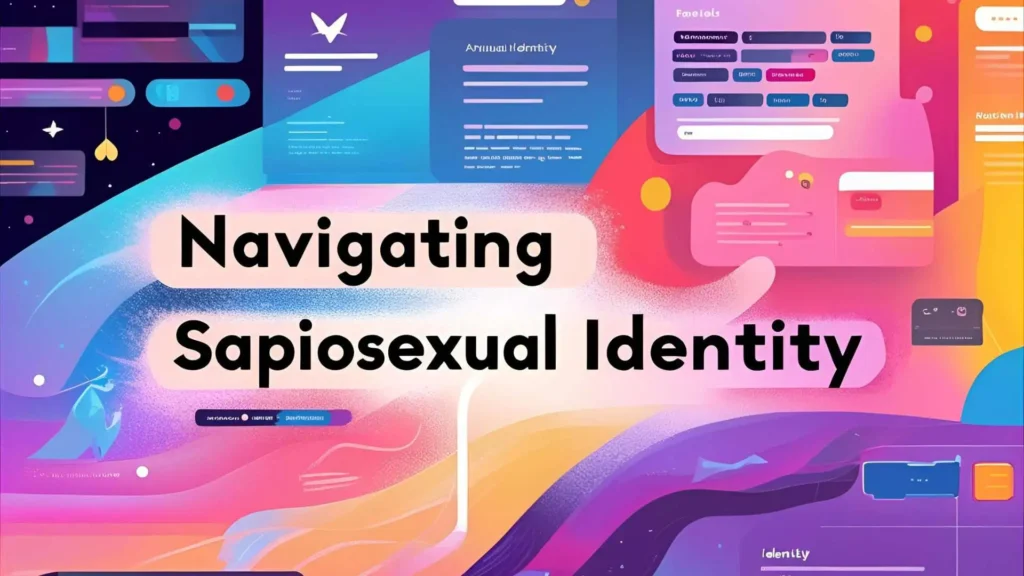When it comes to human attraction, most people think about physical features first—looks, body type, or style. But for some, the real spark comes from the mind.
That’s where the concept of being sapiosexual enters the conversation.
In a world that increasingly values personality, intelligence, and emotional depth, the idea of finding someone attractive because of their intellect has gained traction.
The term sapiosexuality has grown in popularity thanks to online dating apps, social media discussions, and even debates within the broader LGBTQIA+ community. But what does it truly mean to identify as sapiosexual? Is it a legitimate sexual orientation, or simply a personal dating preference? And why has it stirred up both fascination and controversy?
This article unpacks the full meaning of sapiosexuality, its history, psychology, criticisms, and how it shows up in relationships today.
What Does Sapiosexual Mean?
At its core, being sapiosexual means feeling sexually attracted to intelligence rather than physical appearance. A sapiosexual person often experiences desire when they engage in stimulating conversations, witness strong cognitive abilities, or connect with someone’s intellectual curiosity.
Instead of being drawn to features like height, body shape, or fashion sense, sapiosexual individuals focus on the mind as the most attractive quality.
Here’s a breakdown of the distinction:
| Term | Meaning | Key Feature |
| Sapiosexual | Attracted to intelligence | Desire sparked by intellect |
| Demisexual | Attracted only after forming an emotional bond | Emotional closeness first |
| Asexual | Experiences little or no sexual attraction | Non-sexual orientation |
| Heterosexual | Attracted to the opposite gender | Gender-based attraction |
| Gay / Lesbian | Attracted to the same gender | Gender-based attraction |
| LGBTQIA+ | Inclusive umbrella of identities | Multiple attraction patterns |
Unlike orientation labels tied to gender or sex, sapiosexuality shifts the focus toward intellectual attraction. That’s why it is sometimes debated whether sapiosexuality should be considered a true sexual identity or more of a dating preference.
Origins of the Word “Sapiosexual”

The word itself is fairly modern. It blends two Latin roots:
- Sapien – meaning “wise” or “discerning”
- Sexualis – meaning “sexual”
Together, they describe someone who finds wisdom or intellect sexually attractive.
📖 According to Merriam-Webster, the earliest recorded use of the word was in 2004. Since then, its presence has spread across dating apps, academic discussions, and internet culture.
Interestingly, sapiosexuality emerged in Western-centric spaces, which often frame intelligence through Euro-centric measures like IQ tests, higher education, or academic achievement. This bias has sparked debates about whether sapiosexuality unintentionally excludes other forms of intelligence—like emotional wisdom, creativity, or problem-solving that doesn’t align with formal education.
The Psychology of Sapiosexuality
Why do some people feel aroused by intellect? The answer lies in how the brain processes attraction.
- Intellectual stimulation activates areas of the brain associated with reward and pleasure.
- Engaging in deep conversations can release dopamine, the chemical that makes us feel good when we connect with someone.
- For sapiosexual individuals, mental engagement provides the same rush others might get from physical touch or visual attraction.
Psychologists argue that sapiosexuality also ties into self-identity and personal values. Someone who prizes curiosity, learning, or problem-solving may naturally want a partner who reflects those traits.
Traits Sapiosexuals Find Attractive
- A sharp sense of humor rooted in clever wordplay
- Passion for reading, philosophy, science, or art
- Ability to challenge perspectives through thought-provoking dialogue
- Curiosity about the world and eagerness to learn
- Critical thinking and creativity in solving problems
In short, while many people enjoy intelligent conversation, sapiosexuals experience a heightened level of attraction directly linked to those mental sparks.
Sapiosexuality in Relationships

Romantic connections often look different when intelligence is the main driver of attraction.
How Relationships Develop
- Slower progression: Sapiosexual people may not rush into physical intimacy. They need time to gauge intellectual compatibility.
- Conversation as foreplay: Witty banter, debates, or shared learning experiences often feel more exciting than physical flirting.
- Deeper bonds: Long-term relationships rely on mutual respect for each other’s ideas, creativity, and curiosity.
Expectations in Partners
Many sapiosexuals look for traits beyond good looks. Desirable qualities might include:
- Above-average IQ scores or strong reasoning skills
- Passion for reading, science, or philosophy
- Ability to communicate clearly and thoughtfully
- Curiosity about new ideas and cultures
Activities Sapiosexuals Enjoy Together
- Attending lectures or panel discussions
- Visiting museums, art galleries, or live performances
- Reading books side by side and comparing interpretations
- Joining book clubs or study groups together
- Debating current events or philosophical questions over coffee
This kind of relationship prioritizes the mind as the central point of intimacy.
Where Do Sapiosexual People Meet Partners?
While attraction can happen anywhere, sapiosexuals tend to gravitate toward spaces that encourage conversation, learning, or cultural experiences.
Common meeting places include:
- Libraries and bookstores
- Universities or online classes
- Dating apps that allow “sapiosexual” as a preference (like OkCupid, Tinder, and Hinge)
- Museums, art galleries, plays, and live music venues
- Yoga studios, spas, and wellness centers
- Social media forums, intellectual discussion boards, or podcasts
These environments naturally provide opportunities for mentally engaging activities.
How Common Is Sapiosexuality?
Data on sapiosexuality is still limited, but surveys give us some insight.
- Research suggests 1% to 8% of young adults (ages 18–35) identify as sapiosexual.
- The majority of this group self-identifies via online dating platforms or personal exploration rather than formal studies.
- Since the term only appeared in 2004, large-scale research is still developing.
Here’s a simple snapshot:
| Year | Context | Notable Fact |
| 2004 | First recorded use | Merriam-Webster dictionary |
| 2010s | Dating apps rise | Term added as a profile label |
| 2020s | Popularity peak | Wider cultural debates begin |
This raises the question: is sapiosexuality a sexual minority identity, or is it simply an attraction style that cuts across existing orientations like heterosexual, gay, or bisexual?
Criticisms and Controversies

Not everyone embraces sapiosexuality as a valid orientation. Several criticisms have emerged:
Is It Really a Sexual Orientation?
Some argue that sapiosexuality is not a separate orientation but rather a dating preference. Unlike LGBTQIA+ identities, which center on gender or sexual identity, sapiosexuality describes what type of trait is attractive.
Concerns About Ableism
A common criticism is that sapiosexuality can have ableist undertones. By elevating traditional measures of intelligence, it risks excluding:
- Neurodivergent individuals
- People without formal education access
- Those who don’t score highly on IQ-based assessments
Perception of Pretentiousness
Some critics see the label as elitist or pretentious. Claiming to be sapiosexual can sometimes be interpreted as suggesting superiority, as if other attractions are less valid.
Exclusion of Non-Traditional Intelligence
By focusing heavily on academic or logical intelligence, sapiosexuality may overlook:
- Emotional intelligence
- Creative intelligence
- Social and cultural wisdom
This has led to an ongoing debate: should sapiosexuality be respected as a legitimate identity, or is it simply a cultural trend amplified by modern dating?
Cultural and Social Perspectives
The debate around sapiosexuality is deeply tied to cultural biases about what counts as “intelligence.”
- Western-centric definitions often emphasize academic achievement, IQ tests, and formal reasoning.
- Many cultures, however, value storytelling, creativity, wisdom, or emotional understanding as signs of intellect.
- Critics argue that celebrating sapiosexuality without recognizing these differences reinforces Euro-centric and elitist biases.
Inclusion of Neurodivergent Intelligence
There’s a growing call to acknowledge that neurodivergent people—those with ADHD, autism, or other cognitive differences—also display unique and valuable forms of intelligence. Excluding them from the concept of sapiosexuality risks reinforcing narrow views of intellect.
Education and Access
Another cultural concern: education access is not equal worldwide. Linking attraction to academic achievement may unfairly privilege those who had opportunities for higher learning, leaving others overlooked.
Navigating Sapiosexual Identity

For some, identifying as sapiosexual becomes an important part of their self-identity. For others, it’s simply a helpful way to describe preferences.
Exploring Identity
If you’re questioning whether you might be sapiosexual, consider:
- Do you consistently find brains more attractive than looks?
- Do conversations feel more intimate than physical contact?
- Do you lose interest in people who don’t challenge your thinking?
If so, the label may resonate with you.
Talking to Professionals
For deeper exploration, some people consult a mental health professional who specializes in sexual identity. This can help clarify whether sapiosexuality fits within your broader understanding of self.
Tips for Sapiosexual Dating
- Be upfront about valuing intellectual attraction.
- Join communities or groups that encourage curiosity and discussion.
- Balance mental stimulation with emotional connection, since long-term relationships need both.
- Remember: intelligence comes in many forms, not just academic.
FAQ Section
What does sapiosexual mean?
It means being sexually attracted to intelligence rather than physical appearance.
Is sapiosexuality a real sexual orientation?
Debated. Some see it as an orientation, others as a dating preference.
How common is sapiosexuality?
Studies suggest 1% to 8% of adults aged 18–35 identify as sapiosexual.
Where can sapiosexual people meet partners?
Common spaces include libraries, bookstores, online dating apps, and cultural venues.
What are the criticisms of sapiosexuality?
Critics argue it can be elitist, ableist, and overly focused on narrow definitions of intelligence.
Conclusion
Being sapiosexual means finding the greatest turn-on in someone’s mind rather than their body. While still a relatively new concept (first used in 2004), it highlights the diverse ways people experience sexual attraction.
For some, sapiosexuality feels like a genuine sexual orientation, while others dismiss it as more of a dating preference. Whatever the case, it reflects a growing recognition that intellectual stimulation, emotional bonds, and curiosity can be just as powerful in sparking desire as physical attraction.
In the end, whether you’re sapiosexual or not, one truth holds: relationships thrive when partners connect not only through attraction but also through shared values, meaningful conversations, and genuine human connection.

